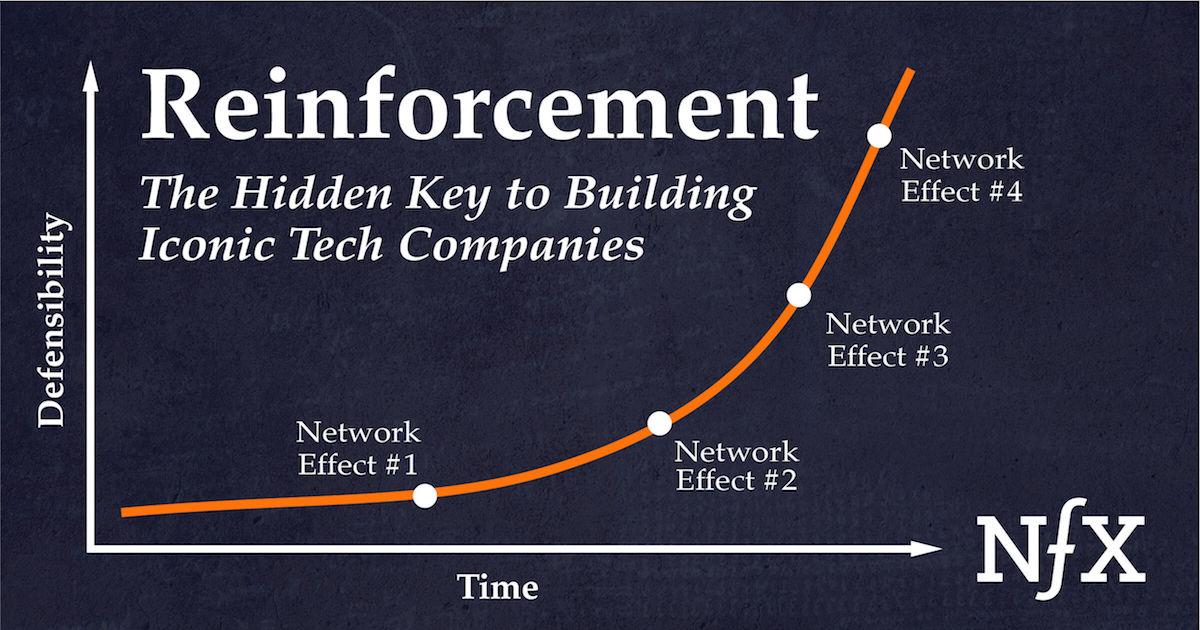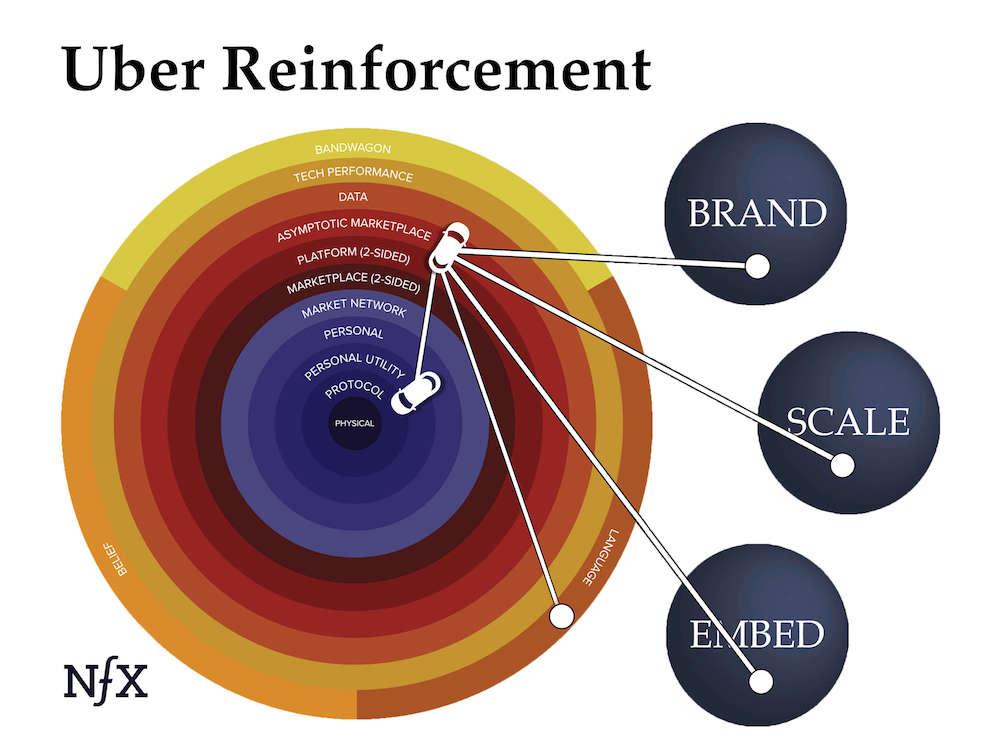

Every iconic company to come out of Silicon Valley in the last 25 years has done the same three things:
- Product-market fit. “Right idea, right time”
- Rapid growth. Scale aggressively (Reid Hoffman calls this Blitzscaling)
- Reinforcement. Build overwhelming defensibility
Of the three, reinforcement is the least talked about and possibly the most important for Founders to understand. The sooner a company starts to reinforce, the greater its chances of success.
The idea behind reinforcement is this: whenever a company adds a new defensibility — either scale, brand, embedding, or network effects — its existing defensibilities become even more powerful. On top of that, reinforcement makes it easier for that company to add further defensibilities — leading to compounding returns.
Any type of defensibility will have a reinforcement effect on all the others, but network effects have the most dramatic impact. This is why companies that start out with core network effects — network effects that are integral to a company’s core business, not arising from features added later — are the easiest to reinforce. It’s also why we think of reinforcement as the network effect of network effects.
Though it may seem like a product of luck from the outside, reinforcement requires deliberate effort. Our network effects case studies on Uber, Facebook, and Trulia describe how these three iconic companies continually add defensibilities throughout their life cycle.
Founders need to be smart enough to recognize opportunities to reinforce when they arise. Just as important, they need to avoid getting overconfident with their existing defensibilities and falling asleep at the wheel.
Build your castle on network effects
Earlier this year, we broke down the many defensibilities that Facebook has built over time — starting with a core personal network effect and expanding to include all four defensibilities along with an impressive six of the thirteen known network effects.


Here’s a recap of Facebook’s defensibility roadmap:
- Personal nfx: Facebook launched in February 2004 with a personal, real-identity online network for Harvard students
- Bandwagon nfx: By the end of 2004, Facebook expanded to multiple Ivy League campuses. Colleges without Facebook felt like they were being left out, creating a strong impulse to bandwagon
- Scale: With their network effects picking up steam, Facebook was able to raise serious funding from Accel and Peter Thiel in May 2005, allowing them to scale aggressively
- Brand: In 2006, major national press coverage propagated Facebook’s mythical dorm room origin story fueling the rise of a strong, recognizable brand
- 2-Sided Platform nfx: Starting with the first F8 conference in May 2007, Facebook rolled out the “Facebook Platform” to encourage app development, albeit with limited success
- Embedding: Leveraging its increasingly powerful defensibility, in 2008 Facebook began embedding its social login throughout the web with the launch of “Facebook Connect”
- 2-Sided Marketplace nfx: Facebook has repeatedly attempted to capture 2-sided marketplace nfx by launching “social” classifieds in 2007, 2009, and 2016 — showing their determination to reinforce and illustrating that companies can have multiple at-bats to capture new defensibilities
- Personal utility nfx: With the launch of Facebook Messenger in 2011, Facebook added a personal utility network effect, making their product more integral to daily life.
- Data nfx: As their time-on-site and user base grew, Facebook began to leverage user data to improve products that enhance user experience and contribute to higher network usage (e.g. News Feed)
Note that all of these defensibilities continually reinforced and empowered the others, as in the following model:
Defensibility (personal nfx) x Defensibility (scale) = Defensibility (Facebook as a whole)
Reinforcement compounds. Adding scale makes Facebook’s personal network even more formidable, and vice versa. Facebook’s level of defensibility is unparalleled as a result.
The effect of reinforcement is reminiscent of Metcalfe’s Law, which states that every new node on a telecommunications network compounds the total value of that network. Similarly, adding a new defensibility “node” compounds the value of the total defensibility of the company, especially if it’s a network effect.
That’s why a “castle” may be a better analogy for defensibility than competitive moats. You can only increase the difficulty of crossing a moat incrementally by digging a wider and deeper moat. But when you reinforce your moat with a castle wall, then reinforce both the moat and the wall with a tower, all the different components work together to increase the impact of each of the others. The defensibility of the castle as a whole undergoes non-linear improvement.


Great companies reinforce early and often
There are a couple of lessons Founders can draw from reinforcement, as employed by iconic companies like Facebook:
- The earlier you start building defensibilities (especially network effects), the more it will work in your favor down the line since new defensibilities will be easier to build and will compound the effects of your existing ones
- Don’t rest on your laurels. When you get one network effect going, hustle to start building the next. That’s how you break away from competition.
The most valuable companies all leverage reinforcement heavily. Even those which don’t start out with core network effects can — and should — add them later.
Amazon is a good case study in how companies can reinforce even if they don’t start out with core network effects.
- In the early days, Amazon raised a lot of capital and grew aggressively. Soon they had a strong scale defensibility, boasting the largest inventory, fastest speed, and lowest prices on the internet
- Leveraging their scale, Amazon then reinforced with data nfx by pioneering community ratings and reviews — adding their first network effect defensibility. Unlike most data nfx, Amazon’s huge and ever-increasing inventory meant there were less diminishing returns from new reviews — i.e. their data nfx were less asymptotic
- Next, Amazon reinforced adding a 2-sided marketplace nfx by opening up a marketplace allowing third-party vendors to sell on Amazon’s website. Over 50% of Amazon transactions now come from hundreds of thousands of such vendors.
- Amazon then built 2-sided platform nfx by developing Alexa, the voice platform. More defensibilities are likely to follow
Salesforce is a good B2B example of reinforcement:
- Salesforce first established defensibility by embedding their CRM tool deeply into customer business operations — the typical enterprise SaaS defensibility.
- They then reinforced with 2-sided platform nfx by developing Force, a platform for enterprise cloud apps.
Uber, as described in a previous nfx case study, was able to compensate for early vulnerability through frenetic reinforcement:


- Uber’s defensibility strategy was initially to go after a two-sided marketplace network effect. However, they found that they fell short of this, and that ridesharing defensibility was actually just an asymptotic network effect, weakened even further by frequent multi-tenanting.
- To shore up this vulnerability, they built up their brand by being loud and constantly attracting press coverage — whether positive or otherwise
- Uber then raised a lot of capital in order to scale aggressively to new markets
- The rapidly ballooning scale of Uber’s ridesharing network enabled them to embed in services like Facebook Messenger and Google Maps
- As they grew more defensible, “Uber” became to become synonymous with on-demand ridesharing. It entered the language as a verb, as in the sentence “I ubered to work today”, adding a language network effect to Uber’s arsenal
Once you see how reinforcement works, it’s clear that companies with defensibilities, like network effects, are rewarded when they add more.
Takeaways for Founders
Iconic companies like Facebook, Amazon, Uber, and Salesforce have great management teams and will continue to reinforce going forward. Each additional defensibility produces increasing value — just like each node on a network subject to Metcalfe’s Law has increasing returns. The incentive to reinforce only increases. As if to prove the point, Facebook announced this year they will be launching a dating marketplace and a blockchain initiative, both of which have network effect properties that will compound the company’s already diverse array of defensibilities.
When you learn to see the distinction between different defensibilities employed by the same company, you’ll be able to recognize how reinforcement works and create an intelligent defensibility strategy for your own company in order to drive exponential value creation.
As Founders ourselves, we respect your time. That’s why we built BriefLink, a new software tool that minimizes the upfront time of getting the VC meeting. Simply tell us about your company in 9 easy questions, and you’ll hear from us if it’s a fit.
